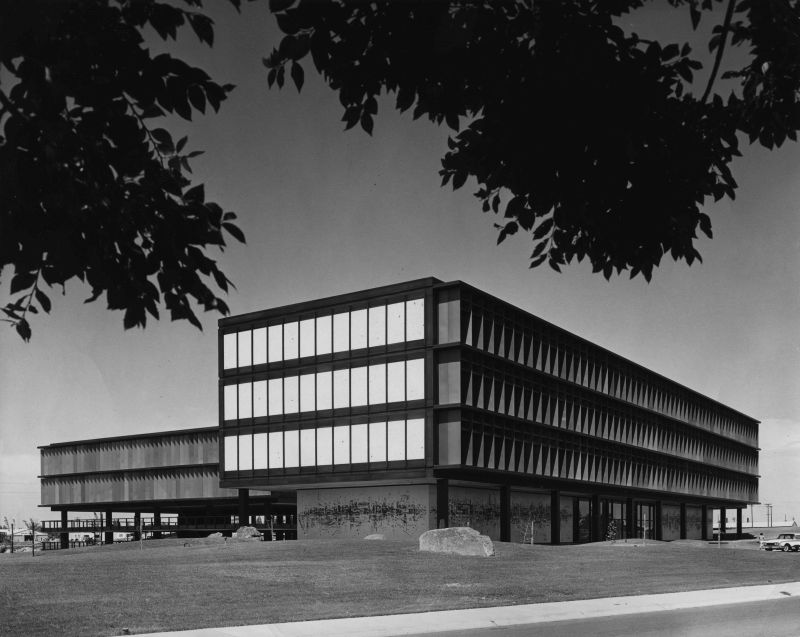Dusting Off an Old Classic
September 10, 2020
From the September 2020 issue of
Architect’s Newspaper.
By Matt Hickman
Wayne Thiebaud’s Water City gets refresh at landmark modernist building in Sacramento
It’s not every day that an architecture firm returns, six decades later, to assiduously renovate and refresh one of its own early works; especially a work that, in this case, helped to put said firm on the map.
But that’s what Sacramento-headquartered Dreyfuss + Blackford Architecture has done with its rehabilitation of the Sacramento Municipal Utility District (SMUD) Headquarters building, a Miesian mid-century landmark whose opening in 1961 established the then-nascent firm as a regional leader in modernist design, even scoring a spread in the real estate section of the New York Times that same year. While the still-busy firm went on to design a diverse number of iconic modernist buildings throughout the Central Valley and beyond the 146,000-square-foot SMUD Headquarters remains one of its most enduring and locally beloved buildings from that era. (Other early highlights from the firm include 1965’s Coffee Tree roadside coffee shop in Vacaville along with its older sister establishment, the famed Nut Tree (1959); the precast concrete IBM Building (1963) at 520 Capitol Mall in Sacramento; and the Mansion Inn (1958), another storied Sacramento landmark that was just recently demolished to make way for housing.)
Tapped by SMUD to modernize the National Register of Historic Places-listed building in 2014, work on the historic preservation-minded project wrapped up August of last year. The top-to-bottom $83 million rehabilitation entailed numerous alterations and upgrades including the addition of a glass-enclosed ground-floor corridor on the north side of the building, a dramatic revamping of the building’s workspaces to reflect the 21st century needs of SMUD’s workforce, the strengthening of the structure’s signature steel frame and glass curtain walls, and the conversion of an enclosed stairwell and mechanical shaft into an open, circulation-improving staircase. Landscaping improvements to SMUD’s park-like 13-acre campus off of S Street in East Sacramento were also completed as part of the overhaul in partnership with landscape architecture firm Callander Associates.
And while renovations to the building’s interior were substantial, a central element of the nearly five-year makeover involved restoring the facade and its defining feature: A monumental glass mosaic mural by famed artist Wayne Thiebaud’s that wraps around three sides of the International-style building’s white-tiled base.
Titled Water City, the aging—but still attention-grabbing—3,650-square-foot mural was strengthened, preserved, and meticulously cleaned using low-pressure water and a dolomite lime solution with much of the focus of the difficult process placed on restoring the original grout, which Kristopher Barkley, president and design director of Dreyfuss + Blackford, described to AN as being “the weak part of the system.” Any broken or missing tile pieces were also replaced. Heading the mural restoration effort alongside Dreyfuss + Blackford was a team of historic preservation architects from Wiss, Janney, Elstner and Associates, Inc. led by Alan Dreyfuss, son of the former firm’s late cofounder, Albert Dreyfuss.
“It’s kind of poetic that we could bring him in to do that work,” said Barkley of the younger Dreyfuss’s involvement.
And while not involved in the restoration work in a professional capacity, Thiebaud himself, who turns 100 this November, was on hand to see his only mural—and, at 15 feet tall and 250 feet wide, his largest completed work in any medium—be lovingly restored to its full, color-drenched glory after work was completed.

Ninety-nine year-old Wayne Thiebaud and his restored Water City mural in Sacramento. (Courtesy SMUD/provided by Dreyfuss + Blackford Architecture)
Best known as a painter, Arizona-born Thiebaud was a largely unknown art teacher at Sacramento City College when he was selected by Dreyfuss + Blackford in 1959 to create a building-integrated work of public art that, in the words of the firm, “would increase interest in the building when viewed both at a distance, through the trees, and up close as people walked under the surrounding portico.” The mural depicts an abstract bird’s eye view of California’s capital city reflected in water.
Today, Thiebaud is considered a living pop art legend (or perhaps more accurately, a pop-art progenitor) whose colorful portraits of quotidian—and often scrumptious-looking—objects and other works are held in the permanent collections of the Los Angeles County Museum of Art, the Whitney Museum of American Art, the Albright-Knox Gallery of Art in Buffalo, the Smithsonian American Art Museum, and many others. In 1994, he was bestowed with the National Medal of Arts by President Bill Clinton.

Work underway installing Thiebaud’s (pictured at top) building-encircling glass tile mural in 1959. (Courtesy SMUD/provided by Dreyfuss + Blackford Architecture)
The creation of Water City was a complex one that involved Thiebaud executing full-sized drawings of his mural on massive sheets of butcher paper, which were then sent to a muralist school in Florence, Italy, where students realized the work in tessera glass tile. The completed individual tiles were then shipped to San Francisco, trucked to Sacramento, and carefully mortared into place on three sides—east, west, and south—of the building’s south wing, which was originally slated to be clad in travertine marble panels until that option was scrapped due to cost concerns. As Barkley explained, Water City was actually Thiebaud’s second proposed mural design for the building after the first “didn’t go over as well.”
“It was a top priority,” Barkley said of the mural’s restoration. “But as was the entire exterior of the building. It was looking pretty tired—precast panels had a lot of rust stains on them, and the aluminum materials on the building really needed to be cleaned up. But overall on the exterior, the rehabilitation was focused on all of the facade, especially the mural.”
It’s worth noting that Water City isn’t the only artistic element on the SMUD campus. Just east of Dreyfuss + Blackford’s restored headquarters building is the Customer Service Center building and its in-lobby art gallery where works by local artists are on display—and on sale—to the public.
